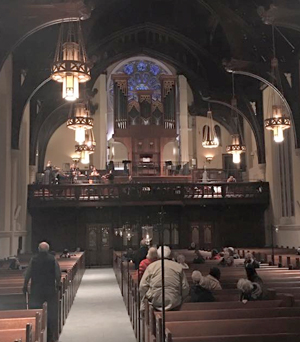by Nicholas Jones

The principal musical offering at this French Baroque Vespers service consisted of the first two of François Couperin’s three exquisitely melancholy Leçons de Ténèbres of 1714. Sparsely voiced for solo soprano and continuo, these pieces are rich settings of dark texts from the biblical Lamentations of Jeremiah, texts that recount the affliction and bitterness of Jerusalem after the Babylonians’ destruction of the city, and call on the people to return to the Lord.
Soprano Margaret Carpenter Haigh delivered these verses with expressive power, exquisite diction, and a clear, flexible voice that filled the Covenant’s large nave. Carpenter Haigh, who sings with such groups as Quire Cleveland and Apollo’s Fire and is pursuing a doctorate in Historical Performance Practice at Case Western Reserve University, skillfully negotiated the rhythms of Couperin’s lush ornamentation as well as adding flourishes and ornaments of her own. She showed a particular sensitivity to Couperin’s intricate text-settings and fast-changing harmonies.
Carpenter Haigh was accompanied by a continuo duo of organist Nicolas Haigh and cellist David Ellis. The Newberry Organ’s ample organ loft, at the rear of the nave, afforded the singer and continuo players excellent sight lines: the ensemble was beautifully coordinated.
Other baroque instrumentalists — presumably also part of the CWRU music program — supplied some incidental music for the service; especially successful was the postlude, a lively chaconne by Georg Muffat. Earlier, Nicolas Haigh brought out the rich coloration of the Newberry Organ with a haunting Récit de Cromorne by Louis Marchand (daringly employing the tremulant) and a grand and reedy Dialogue sur les Grands Jeux by Nicolas de Grigny.
I’m not sure whether Lenten fare is supposed to be as pleasurable as what these excellent young musicians served up. Regardless of liturgical injunctions to penitence, this fine music of the French Baroque was as sweet and loving a Valentine’s Day gift as one could wish for.

Published on ClevelandClassical.com February 16, 2016.
Click here for a printable copy of this article



